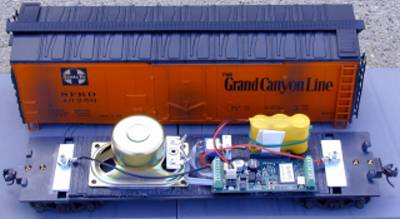Everyone agrees that sound enhances the "believability" and realism of our model locomotives. It is, however, expensive to add, especially when you are thinking of putting sound in each of your locomotives. Many people invest in one diesel sound system and one steam sound system, and install them in boxcars that immediately follow the particular locomotive. This configuration provides for locomotive sound and is also very economical. As you might remember from my previous articles on sound, the use of an enclosure greatly enhances the sound coming from the front of your speaker while minimizing the sound loss from the rear. The use of a boxcar can provide for an excellent sound system enclosure.
The other advantage of an "in car" installation is that it gives you a great deal of room for your sound system card, batteries, and the speaker itself. Because of this available space, you are not limited to the small speakers that come with the sound systems from the factory. You need an 8 Ohm speaker for all sound systems, so any speaker that meets this criteria and will fit inside your boxcar will work. Look for speakers with large rear magnets, and good cone flexibility. I buy my speakers from Phoenix, but many computer speakers work just as well. Most speakers are mounted face down on the floor of the boxcar with the floor is predrilled with holes to let the sound escape. Some people actually cut a hole in the floor of the car to match the speaker size and then put some sort of screen over the speaker holes to eliminate any damage from track ballast, dirt, or water.
If you are using the boxcar shell for your enclosure, you will have to close off the door openings to keep all the sound within the body. This door opening then becomes an ideal place to locate your ON/OFF switches, your sound volume control, and your charging jack. Components are available at Radio Shack for these controls which can be flush mounted and will allow the boxcar door to be closed during operation. While a boxcar makes for a good sound chamber, you may want even greater sound reproduction. To do so, you can enclose the speaker in a box within the boxcar. This box can be made from acrylic plastic joined together with silicone to minimize vibration
You will have to change your box car trucks out to those with metal wheels to allow for power pickup. These are available from LGB, USA or Aristo. When using these metal wheels on the boxcar for track power pickup, make sure you keep them clean and the track clean. We have found through experience, that dirt will cause the sound system to not function properly, or in some cases, not work at all. Remember, the sound system uses a battery to produce the sound, but needs track power to re-charge the battery, and also to sense voltage changes to perform the necessary start, stop, speed up and slow down sound functions. If you are putting a steam sound system in your box car, remember that you have to put your chuff magnets on the axel of one of the boxcar wheel sets for this feature to function. You will also have to mount your reed switches on the boxcar if you are using them to trigger any sounds such as bell or whistle.
Another option would be to have a jumper with a plug that can be directly connected to your locomotive motor, so that the sound system can sense the increase or decrease in track voltage from the motor pickup and react accordingly. One additional option for this installation would be to install the sound system in the boxcar, but place the speaker in the locomotive tender. A plug and jumper wire between boxcar and tender would allow the sound to be transmitted from the locomotive rather than the boxcar. Whatever way you choose to hook up your sound, you will always retain the flexibility of having one sound system that will work with each of your locomotives.
Jim Hopes, one of our Tampa Bay members, has been very successful in building and using a sound car for his many diesel locomotives. He has installed a large speaker in both his sound cars which really brings out the base tone and realism in his trains.

